Microphones for Noise Cancellation
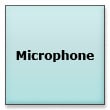 In a typical audio application, a
microphone
is the device which captures sound waves as they are emitted from their source and passes them on to be
converted into electrical signals for a variety of uses. In a
noise cancellation application
, microphones are used to register noise waves which need to be silenced. The
microphones
pass these waveforms on into the system to generate the anti-noise waveforms which are then emitted to
cancel out the noise.
In a typical audio application, a
microphone
is the device which captures sound waves as they are emitted from their source and passes them on to be
converted into electrical signals for a variety of uses. In a
noise cancellation application
, microphones are used to register noise waves which need to be silenced. The
microphones
pass these waveforms on into the system to generate the anti-noise waveforms which are then emitted to
cancel out the noise.
Microphone Amplifiers for Noise Cancellation
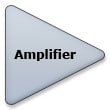 A
microphone pre-amplifier
boosts signals, typically to line-level (the level needed to transmit analog signals point-to-point, between
devices.) Further amplification may be necessary. The noise performance of a
pre-amp
is critical since the final signal-to-noise ratio of downstream
amplifiers
can be magnified. For an audio input application, such as microphones, the
pre-amp
is physically mounted near the sensor that feeds it, to reduce noise and interference.
A
microphone pre-amplifier
boosts signals, typically to line-level (the level needed to transmit analog signals point-to-point, between
devices.) Further amplification may be necessary. The noise performance of a
pre-amp
is critical since the final signal-to-noise ratio of downstream
amplifiers
can be magnified. For an audio input application, such as microphones, the
pre-amp
is physically mounted near the sensor that feeds it, to reduce noise and interference.
Automatic Gain Control (AGC) for Noise Cancellation
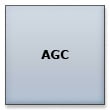 Automatic Gain Control
(
AGC
) is a function that may also be provided by a
Programmable Gain Amplifier
(
PGA
) in an electronic circuit. This function dynamically adjusts gain, typically via a feedback signal, to
shape the output signal to the desired amplitude in response to external conditions.
AGC
can be used to provide near real-time control and may also be referred to as
adaptive control
.
Automatic Gain Control
(
AGC
) is a function that may also be provided by a
Programmable Gain Amplifier
(
PGA
) in an electronic circuit. This function dynamically adjusts gain, typically via a feedback signal, to
shape the output signal to the desired amplitude in response to external conditions.
AGC
can be used to provide near real-time control and may also be referred to as
adaptive control
.
DSPs for Noise Cancellation
 A
digital signal processor
(
DSP
) is a specialized
microprocessor
usually with a modified Harvard architecture and a single cycle multiply-and-accumulate required for the
fast operational needs of processing and for mathematically manipulating real-world signals like voice,
audio, and video. In a
noise cancellation
application, the
DSP
examines the characteristics of the input noise waveform. The DSP then generates the anti-noise waveform
which effectively negates the input noise waveform. The human ear then hears less "white" noise as the
cancellation occurs in real, or near-real time.
A
digital signal processor
(
DSP
) is a specialized
microprocessor
usually with a modified Harvard architecture and a single cycle multiply-and-accumulate required for the
fast operational needs of processing and for mathematically manipulating real-world signals like voice,
audio, and video. In a
noise cancellation
application, the
DSP
examines the characteristics of the input noise waveform. The DSP then generates the anti-noise waveform
which effectively negates the input noise waveform. The human ear then hears less "white" noise as the
cancellation occurs in real, or near-real time.
Audio Codecs for Noise Cancellation
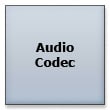 A
codec
encodes
data for transmission and/or
decodes
it for playback. Essentially, a codec has one or more
Digital-to-Analog data converters
(
DAC
) and
Analog-to-Digital converters
(
ADC
) in a single package. A
codec
is essential for the use of
Digital Signal Processors
(
DSPs
) in audio applications, since can convert real-world analog signals (like sound) to digital signals for the
DSP, and back again from
digital
to
analog
for the human ear.
A
codec
encodes
data for transmission and/or
decodes
it for playback. Essentially, a codec has one or more
Digital-to-Analog data converters
(
DAC
) and
Analog-to-Digital converters
(
ADC
) in a single package. A
codec
is essential for the use of
Digital Signal Processors
(
DSPs
) in audio applications, since can convert real-world analog signals (like sound) to digital signals for the
DSP, and back again from
digital
to
analog
for the human ear.
DACs for Noise Cancellation
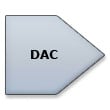 A
digital-to-analog converter
(
DAC
) is a semiconductor device that is used to convert a
digital
code (usually binary) into an
analog
signal, such as electric charge, current, or voltage. An analog-to-digital converter (ADC) performs the
reverse operation. A
DAC
is the principal means by which computer and digitally-based systems translate digital data into real-world
signals.
A
digital-to-analog converter
(
DAC
) is a semiconductor device that is used to convert a
digital
code (usually binary) into an
analog
signal, such as electric charge, current, or voltage. An analog-to-digital converter (ADC) performs the
reverse operation. A
DAC
is the principal means by which computer and digitally-based systems translate digital data into real-world
signals.
Speaker Amplifiers for Noise Cancellation
 A
power
or
audio amplifier
is typically used to greatly increase the signal strength, or amplitude, of a current or voltage signal. In
audio applications, late stage "
power
"
amplifiers
in a signal chain can be used to increase the power output of a signal such that the signal can physically
move, or drive, the diaphragms in a loud speaker.
A
power
or
audio amplifier
is typically used to greatly increase the signal strength, or amplitude, of a current or voltage signal. In
audio applications, late stage "
power
"
amplifiers
in a signal chain can be used to increase the power output of a signal such that the signal can physically
move, or drive, the diaphragms in a loud speaker.
Speakers for Noise Cancellation
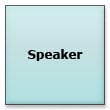 In any audio application,
speakers
are the components that take the stored electronic signals and turn them back into actual sound, supplying
the end-result of the audio system for listeners to hear. In an ideal noise cancellation application, a
noise cancellation speaker
emits the anti-noise waveforms which cancel out the offending noise waveforms so that instead of noise, the
listener hears near silence.
In any audio application,
speakers
are the components that take the stored electronic signals and turn them back into actual sound, supplying
the end-result of the audio system for listeners to hear. In an ideal noise cancellation application, a
noise cancellation speaker
emits the anti-noise waveforms which cancel out the offending noise waveforms so that instead of noise, the
listener hears near silence.
Boost Converters for Noise Cancellation
 A
DC/DC boost converter
, also known as a
step-up converter
, is a semiconductor device or electrical circuit that has an output DC voltage that is greater than the DC
input voltage. The amount of output current will be lower than the source current, however.
Boost converters
can increase the voltage and thus reduce the total number of battery cells required for portable
applications.
A
DC/DC boost converter
, also known as a
step-up converter
, is a semiconductor device or electrical circuit that has an output DC voltage that is greater than the DC
input voltage. The amount of output current will be lower than the source current, however.
Boost converters
can increase the voltage and thus reduce the total number of battery cells required for portable
applications.
DC / DC Buck Converters for Noise Cancellation
 A
buck converter
is a power efficient voltage
step-down converter
that changes a higher voltage to a lower voltage. Whereas a linear regulator can achieve the same purpose,
regulators can waste more energy via conversion of excess energy to heat. Thus, for this reason a
buck DC/DC converter
is the preferred choice for power-efficient designs such as portable electronics.
A
buck converter
is a power efficient voltage
step-down converter
that changes a higher voltage to a lower voltage. Whereas a linear regulator can achieve the same purpose,
regulators can waste more energy via conversion of excess energy to heat. Thus, for this reason a
buck DC/DC converter
is the preferred choice for power-efficient designs such as portable electronics.
Low Drop Out (voltage) Regulators for Noise Cancellation
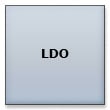 A
Low Drop Out
(
voltage
)
Regulator
is a voltage regulator that automatically maintains a constant voltage level and features a low potential at
below which it can no longer reliably regulate.
LDO
s stabilize input or supply voltages so processors and other sensitive electronics can do their jobs.
LDO
s are instrumental in enabling the power-efficient portables in use today because they enable very low
minimum operating voltages.
A
Low Drop Out
(
voltage
)
Regulator
is a voltage regulator that automatically maintains a constant voltage level and features a low potential at
below which it can no longer reliably regulate.
LDO
s stabilize input or supply voltages so processors and other sensitive electronics can do their jobs.
LDO
s are instrumental in enabling the power-efficient portables in use today because they enable very low
minimum operating voltages.
Supply Voltage Supervisors for Noise Cancellation
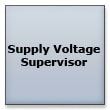 Supply Voltage Supervisors
monitor the primary voltage that feeds embedded electronics circuits for low voltage conditions, thus
improving system reliability.
Voltage supervisors
ensure a proper system power-up and power-down and work to provide an environment for a smooth and
trouble-free system. For example, a
voltage supervisor
can be made to reset a controller if supply voltage conditions are too low for proper operation of the
controller and keep it in a reset mode until the unstable supply voltage conditions resolve.
Supply Voltage Supervisors
monitor the primary voltage that feeds embedded electronics circuits for low voltage conditions, thus
improving system reliability.
Voltage supervisors
ensure a proper system power-up and power-down and work to provide an environment for a smooth and
trouble-free system. For example, a
voltage supervisor
can be made to reset a controller if supply voltage conditions are too low for proper operation of the
controller and keep it in a reset mode until the unstable supply voltage conditions resolve.